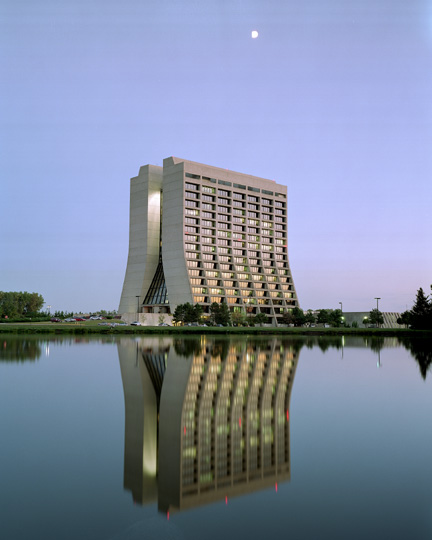This was supposedly the Fermilab Wilson Hall (aka Hirise), the landmark administrative building of the Illinois Laboratory (see picture below); however, as in most dreams, reality was slightly modified. The building was not shaped like a capital "A", although it shared some distinctive characteristics with it: like the Hirise it had an internal empty space, but this was with cylindrical symmetry: it was basycally a cylinder, sightly narrowing toward the top. Thinking about it, this was sort of the merging of the Hirise with Building 40 at CERN - which has a central core which is in fact exactly cylindrical, with an empty center. The building in the dream however was much taller than either of the two real-life examples.
 As the earthquake struck the building started to oscillate. Being in a top floor, the oscillations were powerful and scary - it looked like the concrete of the pillars which lined up around the internal empty space would shatter. I realized there was no time to try and leave the building, so I moved close to one of the pillars for increased protection, and noticed that the movement was a circular oscillation: the building was twisting around its symmetry axis.
As the earthquake struck the building started to oscillate. Being in a top floor, the oscillations were powerful and scary - it looked like the concrete of the pillars which lined up around the internal empty space would shatter. I realized there was no time to try and leave the building, so I moved close to one of the pillars for increased protection, and noticed that the movement was a circular oscillation: the building was twisting around its symmetry axis.As I woke up I started reasoning on whether this is at all possible for a building with that shape hit by an earthquake. The math describing the coupling of the various oscillatory modes of such a structure involves very complex differential equations, and although extremely interesting, it is not for a blog post; suffices to say that in the presence of multiple "principal modes" of oscillation one can often study each mode independently, and then combine the results, rather than try and solve the coupled differential equations at once.
 Being lazy I took the web shortcut. Upon digging a bit I found a document describing a seismic analysis of a building which is not too different from the one in my dream, the California 101 building in San Francisco (see picture). There, the analysis concentrated on the particular shape of the building, which has a triangular base, and the coupling of the two parts determines a complex motion in the event of a strong earthquake. However, that did not appear to "explain" the circular oscillation I "experienced" in my dream...
Being lazy I took the web shortcut. Upon digging a bit I found a document describing a seismic analysis of a building which is not too different from the one in my dream, the California 101 building in San Francisco (see picture). There, the analysis concentrated on the particular shape of the building, which has a triangular base, and the coupling of the two parts determines a complex motion in the event of a strong earthquake. However, that did not appear to "explain" the circular oscillation I "experienced" in my dream...But then I found a very illuminating PhD thesis which dealt exactly on that topic. I thus learned that indeed, circular motion can be excited by a horizontal seismic stimulation. This can be caused by a non-coincidence between the center of gravity and the center of rigidity of sections of the building. Let me quote a couple of sentences in the document:
"It is obvious that torsional coupling in seismic response is due to the asymmetric arrangement of structural elements, i.e. the center of mass at the floor does not coincide with the center of rigidity of the same story."and
"These studies have led to a number of important conclusions. The dynamic torque may exceed considerably the product of horizontal shear times the eccentricity between the center of mass and resistance[...] The lateral and torsional motions are strongly coupled if the lower natural frequencies of the building are nearly equal, even for those buildings with nearly coincident centers of mass and resistance[...]
Among the conclusions I draw from the un-careful reading of the thesis is the fact that indeed, a significant torque of a building can occur during a horizontal seismic activity. For it to be significant, the direction of the horizontal force exerted on the building must be orthogonal to the displacement between the center of mass and rigidity of the building.
The effect I experienced in my dream was large - I was subjected to a circular oscillation much more than a horizontal one - but it was not unphysical. Only, one must assume that the building had its center of mass displaced with respect to its axis of symmetry, for some reason. I will investigate the matter more thoroughly if I chance to dream that place again !



Comments